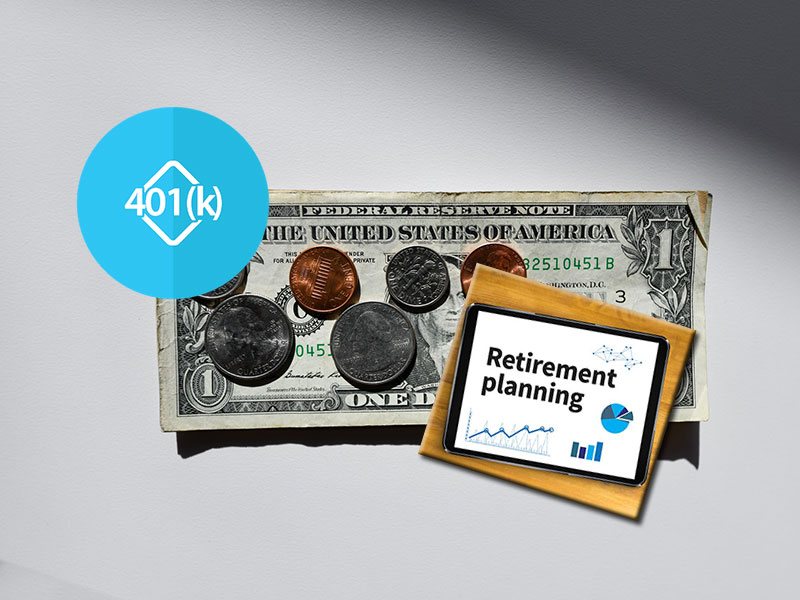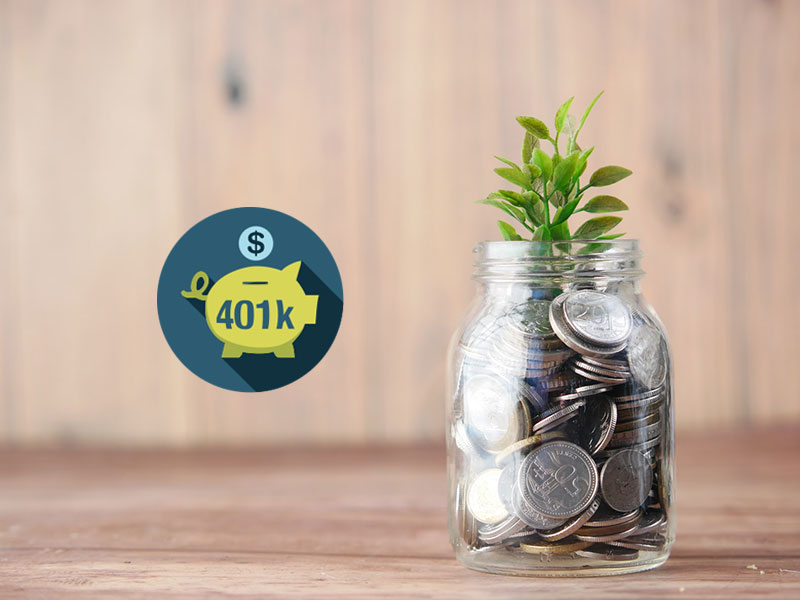Retirement is a big consideration. Mostly because of the financial aspect of it, people everywhere are aware of the need to save and prepare for a successful and restful retirement.
Of all the many financial vehicles out there to help people reach their retirement goals, the 401k plan is one of the most popular, especially because a 401k rate of return can be very strong (typically, between 5% and 8%), depending upon where the money is invested.
By making a solid plan and following it consistently, anyone can use a 401k to build up a retirement nest egg that affords them long-term financial independence and security.

Table of Contents
401k Benefits and Basics
Making a plan for retirement savings isn’t necessarily as hard as it may seem. With so many people around the country utilizing 401k plans as part of their strategy, it’s easy to see that a 401k can be a great tool. But what exactly is a 401k?
What is a 401k?
A 401k is a tax-sheltered account designed for retirement savings. The U.S. Internal Revenue Code subsection 401k, which was established in 1978, is what defines the 401k. Essentially, a 401k allows employees (and their employers) to set aside money pre-tax and invest it for their retirement.
That simply means that the initial contributions they make to their 401k account are not taxable. Later on, however, when they withdraw their 401k funds in retirement, those withdrawals are taxed as income.
The 401k has become one of the primary ways that people save for retirement. In fact, it has become so established that National 401k Day is officially recognized each year on the first Friday after Labor Day (so National 401k Day 2022 is on September 9.)
What are the benefits of having a 401k?
There are many benefits of having a 401k, including the following:
- The money in your 401k belongs to you
- Your contributions are tax-deferred
- You can contribute conveniently straight out of your paycheck
- Many employers offer contribution matches
- You can roll your 401k over to another company when you change jobs
- Your 401k funds can have great growth potential depending upon what they are invested in
Even if your employer does not offer a contribution match, they will likely offer you convenient access to a 401k plan. This makes it easy to save for retirement and is a great way for companies to invest in their employees.
Furthermore, while it may seem obvious, it’s important to understand that the money in your 401k is 100% yours. So it’s your prerogative to make changes to how it is invested. Simply ask your employer what your options are to be sure that you aren’t missing out on investment opportunities with your account that you might otherwise miss.
For example, if you’re younger, you might want to invest your 401k more aggressively. But if you’re approaching retirement age, you might prefer to start moving your 401k funds into investments that are steadier and less volatile.
What are the rules for 401k withdrawals?
There are certain rules for how to actually withdraw and use 401k funds.
Most importantly, 401k funds cannot be withdrawn without penalty before the account holder is 59 1/2 years old. The penalty for withdrawing 401k funds early is 10% of the withdrawal. Remember that the withdrawal will also be taxed as income (as is the case with a penalty-free withdrawal).
There are, of course, situations that may require someone to withdraw from their 401k early and simply take the penalty. But if at all possible it is best not to in order to avoid the fees associated with doing so.
It’s also important to note that there are certain situations in which the government may offer people some amount of penalty-free early access to their retirement funds.
The 10% penalty might be waived for you if:
- You agree to receive equal payments (officially called “substantially equal periodic payments” or SEPP) at intervals for the rest of your life
- You are over 55 years old and end up leaving your job
- You go through a divorce and must allocate 401k funds between you and your ex-spouse
- You have costs associated with Covid-19 (per the CARES Act of 2020)
- You experience unexpected disability
- You had a baby or adopted that year
- You were affected by an IRS-recognized disaster
- You want to get out of a 401k that you didn’t choose to have
- You are called into active duty as a military reservist
- You use the money for paying a levy to the IRS
But even in many of these situations, if at all possible it is generally best not to veer off of one’s savings plan for retirement.
What is the average 401k return on investment?
One of the most important aspects of any investment is the return it gives you. This is especially true for a 401k. For many people, even consistent contributions throughout their career may not be enough on their own to retire comfortably. That’s why the compound interest that comes with investing is so important.
Understanding Compound Interest
Compound interest simply refers to the exponential growth of an initial investment by percentages over time. For example, if you put $100 in an investment that yields 10% growth every year, your investment is not just gaining $10 every year. It actually gains $10 the first year, $11 the second year, $12.10 the third year, and so on and so forth.
At the end of the tenth year, then, that initial $100 investment would be worth $259.37. You can see how compound interest, applied to higher dollar amounts, is a powerful force for building wealth. And it isn’t difficult to calculate potential returns. Online compound interest calculators are a great tool for investors to financially plan and get a good sense of what to expect from their savings over time.
Compound interest from the growth of your investments is especially key. Because it will allow your retirement funds to outpace inflation. It will even grow beyond that to increase your nest egg in the long run.
What is the average return on investment for a 401k?
The average return on investment (ROI) for a 401k is hard to pinpoint. But experts typically cite the expectation of 5% to 10% annual growth on average. This means that despite the fact that some years your 401k may be down and others years it may be up (due to market fluctuations). Over time you can expect it to grow exponentially.
If you do indeed see numbers like those cited above, you are in good shape to outpace inflation and also see positive growth for your nest egg before retirement.
How to Calculate Rate of Return
To see whether your investments are keeping up with the average 401k return of 5-10% for any given year, all you need is the starting and ending balances of your 401k for that year. First, subtract the starting balance from the ending balance to get the difference.
Then divide that difference by the starting balance to get the rate of return your 401k saw that year.
For example, if your 401k’s starting balance one year is $10,000 and then it ends the year at $11,000. The difference is $1000 (which is simply $10,000 subtracted from $11,000). Then, by dividing $1,000 (the difference) by $10,000 (the starting balance), you’ll find that the ROI for that year is the decimal 0.1 or 10%.
How often should one contribute to their 401k?
Your 401k contribution frequency is an important aspect of making a plan and sticking to it.
While everyone’s situation is different, first and foremost it’s key to choose how often you want to contribute to your 401k and make sure it happens. A good place to start is to ask your employer to withhold a certain amount from each paycheck. And automatically contribute it to your 401k for you.
If that doesn’t work for you, it’s good to create a recurring contribution on at least a monthly basis to make sure that your money is able to grow in the 401k as early as possible. In other words, compound interest is always at work in investments. So investing your money as soon as possible can yield better returns over time.
Making a Goal
It’s important to plan out what you will need for a comfortable retirement. And that means coming up with a dollar amount for your nest egg that you are shooting for. Depending upon whether you want to live off of the growth of your investments, dividends from your investments, or passive income of other kinds, the amount you need in your 401k by retirement will differ.
Vanguard, a leading investment management company, has shown from their research that the average 401k balance for those aged 55-64 is just over $230,000. This is certainly on the low end of what a comfortable retirement typically requires. But it’s also important to note that in many cases people do (and should) have other investments and income sources for their retirement other than their employer-provided 401k.
Considering your entire investment portfolio, from the property you own to your 401k. It’s important to make a plan to build up your nest egg and passive income streams sufficiently by retirement age, which is currently 62 on average.
Environment-Friendly Investments
There are typically different investment options offered by any given provider of a 401k. While not an option with any investment company, some might offer environmental-friendly investment portfolios. That allow you to invest your money while also protecting wildlife and contributing to conservation. This kind of investment can be particularly meaningful if you have a passion for being a good steward of the earth.
Tips to Maximize Your Retirement Funds
Start Investing Early
Because of the nature of compound interest, starting to invest in a 401k as early as possible can have a great impact on how much you retire with.
For example, if you plan to retire at age 60, an initial investment of $5000 (without any subsequent contributions) growing by 10% annually would increase to about $87,000 if you were to invest it at age 30. That’s not bad, but if you invested it at age 20 instead, it would increase to $140,000. Which is a difference of $53,000 just for getting started five years earlier.
Learn about Good Money Management
Learning about good money management is also important. Basic principles of managing (and avoiding) debt, for example, can save you lots of trouble throughout your life. And getting a good grasp on how the stock market and other investments work can also be integral to you maximizing the effectiveness of your investment portfolio.
Websites like Fiscal Tiger offer great teaching resources for learning how to better manage your money and reach your financial goals.
Other Retirement Savings Options to Consider
There are several other ways to invest for your retirement in addition to utilizing a 401k.
Roth IRAs
One great alternative way to invest your money for retirement and keep up with the average 401k return on investment is to use what is called a Roth IRA. Roth IRAs are essentially personal retirement accounts. They differ from 401k’s in a couple of significant ways.
First, they don’t offer the same kind of tax advantage. Whereas 401k contributions are treated as pre-tax income and later the withdrawals are taxed, Roth IRAs are the exact opposite. Contributions to a Roth IRA are not treated pre-tax, so you’ll still pay taxes on that money in the year that you invest it.
However, down the road when you withdraw from your Roth IRA, those withdrawals (including the growth, which could be significant) will not be taxed.
Second, Roth IRAs have a smaller annual contribution cap. Currently, if you’re under age 50, the limit to Roth IRA contributions in any given year is $6,000, and if you’re 50 or older the limit is $7,000 annually.
Real Estate
Real estate is another great option for investing in retirement. This might mean simply paying off your house to reduce the cost of living in retirement. Or it might also mean investing in multiple properties to rent out and have passive income streams. It might mean a combination of these options.
Regardless, real estate as an investment has proven itself to be reliable and great for growth over the decades.
In the end, investing intentionally in a 401k is a great way to save and prepare for retirement. It’s important to make a goal for how much you’ll need. Make a plan for regularly investing in your retirement nest egg, and execute that plan as soon as possible. With regular contributions and even just an average 401k rate of return, you’ll be able to look forward to a retirement of comfort and stability.





